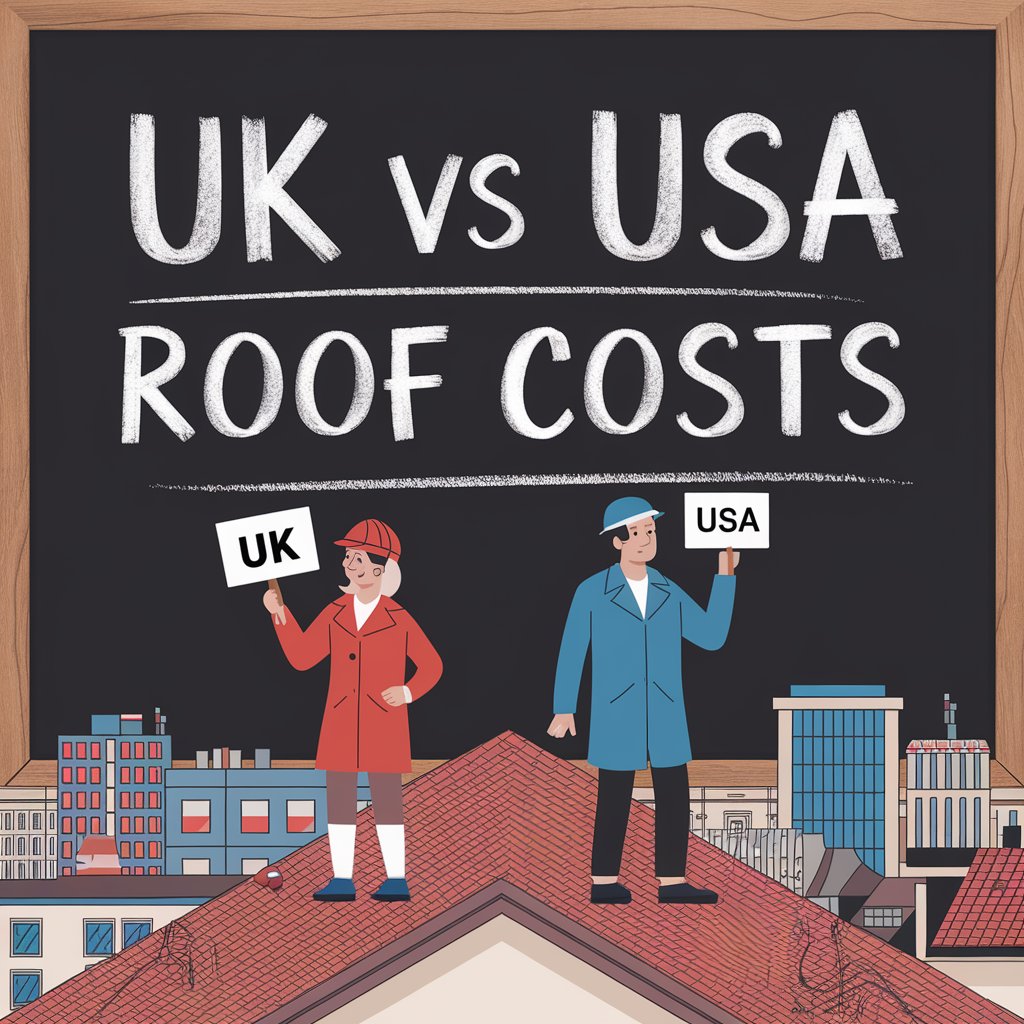According to recent reports, the average cost of a new roof in the UK ranges from £5,500 to £13,500, while in the USA, prices typically fall between $8,000 and $15,000 (approximately £6,300 to £11,800). These variations depend on factors such as roof size, materials, and regional differences.
Comparative Material Costs: UK vs USA
Roofing material costs differ significantly between the UK and USA, influenced by factors like availability, import costs, and local preferences. In the UK, common roofing materials include clay tiles, concrete tiles, and slate, while in the USA, asphalt shingles are the most prevalent.
- Clay Tiles: In the UK, clay tiles typically cost between £30 to £80 per square metre. In contrast, asphalt shingles in the USA are much cheaper, ranging from $70 to $160 per square (equivalent to approximately £5.50 to £12.60 per square metre).
- Concrete Tiles: In the UK, concrete tiles range from £20 to £50 per square metre.
- Slate: A premium option in the UK, slate can cost £60 to £100 per square metre.
- Metal Roofing: Metal roofing shows a notable price difference between the two countries. In the UK, it costs around £40 to £65 per square metre, while in the USA, prices range from $120 to $900 per square (£9.50 to £71 per square metre), depending on the type of metal used.
- Flat Roofing Materials: EPDM (a synthetic rubber roofing membrane) in the UK costs £80 to £100 per square metre, whereas in the USA, it’s generally less expensive, ranging from $3.50 to $7.50 per square foot (£27 to £59 per square metre).
Material prices have seen significant fluctuations in recent years. The construction materials price index in the UK decreased by 2.0% in December 2023 compared to the previous year. However, both countries have faced supply chain disruptions and increased demand, leading to price volatility.
The choice of roofing materials reflects different building traditions and climate considerations. For instance, timber-frame construction in the USA makes lightweight asphalt shingles popular, while the UK’s preference for masonry construction allows for heavier materials like clay tiles. While some materials may be less expensive in the USA, factors such as longevity and climate suitability often justify the higher upfront costs of materials commonly used in the UK. For example, clay tile roofs in the UK can last over 100 years, compared to the 20-30 year lifespan of typical asphalt shingle roofs in the USA.
New vs Replacement Roof Costs: UK vs USA
When comparing new roof installation versus roof replacement costs in the UK and USA, several key differences emerge.
UK Roof Costs
In the UK, the average cost for a new roof installation on a typical 3-bedroom semi-detached house ranges from £5,000 to £7,000. For a full roof replacement, costs are similar, typically falling between £5,500 and £7,000. However, for larger or more complex roofs, replacement costs can rise to £7,000 to £15,000.
Replacement Costs by Material
- Tiled Roof Replacement: For a 2-3 bedroom terraced/semi-detached house, costs range from £3,000 to £3,800.
- Slate Roof Replacement: For a 2-3 bedroom terraced/semi-detached house, costs range from £4,000 to £5,500.
- Flat GRP Roof Replacement: For a standard size garage, costs range from £1,000 to £1,500.
The What Price website offers a replacement roof cost calculator which you can find by clicking here.
USA Roof Costs
In contrast, new roof installation costs in the USA tend to be higher, averaging between $8,000 and $15,000 (approximately £6,300 to £11,800). This difference can be attributed to factors such as higher labor costs and different building practices in the USA.
Replacement Costs by Material
- Asphalt Shingle Roof Replacement: Costs range from $5,700 to $12,000 (£4,500 to £9,500).
- Metal Roof Replacement: Costs range from $5,000 to $14,000 (£3,950 to £11,000).
- Slate Roof Replacement: Costs range from $25,000 to $50,000 (£19,700 to £39,400).
Cost-Effectiveness of Replacement vs. New Roof
In both countries, replacing a roof is often more cost-effective than installing a completely new roof structure. This is because replacement typically involves reusing existing structural elements, reducing labor and material costs.
Factors Influencing Costs
Several factors influence roofing costs in both the UK and USA:
- Size and Complexity of the Roof: Larger and more complex roofs require more materials and labor, increasing costs.
- Type of Roofing Material: Different materials vary significantly in price, with options like slate and metal being more expensive than asphalt or tiles.
- Labor Costs: Labor rates can vary widely by region. For instance, urban areas often have higher labor costs than rural areas.
- Accessibility of the Roof: Difficult-to-access roofs may incur additional costs due to the need for specialized equipment or scaffolding.
- Removal and Disposal of Old Materials: The cost of removing and disposing of the old roof materials can add to the overall expense.
- Necessary Structural Repairs: If there are underlying structural issues, additional repairs may be required, further increasing the total cost.
Additional Costs
- UK: Homeowners should budget for extra costs such as scaffolding (£800 to £900 per week) and waste disposal.
- USA: Additional costs may include permits, inspections, and potential structural reinforcements.
Labour Costs and Regional Variations
Labour costs for roof installation vary significantly between different regions in the UK and USA, as well as within each country.
- UK Labour Costs: Typically range from £150 to £200 per day per worker. Regional variations are notable, with London prices reaching £37 to £40 per hour, while in areas like Plymouth, they may be as low as £20 to £26 per hour.
- USA Labour Costs: American roofers charge between $50 and $80 per hour on average, but this varies widely depending on the state and whether the location is urban or rural.
Labour costs often make up a significant portion of the total roofing expense. In the UK, labour can account for 50% or more of the total roof replacement budget. Regional economic factors, such as the cost of living and local demand for roofing services, play a significant role in determining labour costs. Additionally, the complexity of the roof and the type of materials being used can influence labour costs.
When budgeting for a new roof, it’s crucial to factor in these regional variations and obtain quotes from local contractors to get an accurate estimate of labour costs in your specific area.
Impact of Climate on Roofing Choices
Climate plays a crucial role in determining appropriate roofing materials and designs for homes in both the UK and USA. In areas with heavy rainfall or snowfall, steeper roof pitches and materials with excellent waterproofing capabilities are essential to prevent leaks and water damage.
- Hot Climates: Require roofing materials that can withstand prolonged UV exposure and reflect heat, such as cool roofs with reflective surfaces, to reduce energy consumption and extend roof lifespan.
- Coastal Regions: Prone to high winds and salt exposure benefit from corrosion-resistant materials like stainless steel or copper. Additionally, climate change is driving the adoption of more resilient roofing solutions, including impact-resistant materials in storm-prone areas and green roofs that provide natural insulation and help manage stormwater runoff.
As extreme weather events become more frequent, the roofing industry in both countries is adapting by developing new materials and technologies to enhance durability and energy efficiency in changing climates.
Sustainability and Material Sourcing
Sustainability and responsible material sourcing have become increasingly important in the roofing industry for both the UK and USA. This shift is driven by growing environmental awareness, stricter regulations, and consumer demand for eco-friendly building practices.
- UK: Emphasizes locally sourced materials to reduce transportation emissions and support the domestic economy. For instance, Welsh slate is highly prized for its durability and low environmental impact. The UK government has introduced initiatives like the Sustainable Procurement Action Plan to encourage the use of responsibly sourced construction materials.
- USA: The U.S. Green Building Council’s LEED certification program has been influential in promoting the use of environmentally friendly roofing materials. This has led to an increase in the use of recycled and recyclable roofing products.
Both countries are seeing a rise in the use of sustainable roofing materials like metal roofing, clay and concrete tiles, slate, green roofs, and recycled shingles. The sourcing of these materials is also under scrutiny, with many manufacturers now providing Environmental Product Declarations (EPDs) that detail the environmental impact of their products throughout their lifecycle. This transparency allows contractors and homeowners to make more informed decisions about the sustainability of their roofing choices.
Both countries are also seeing innovations in sustainable roofing technologies. For example, solar tiles that integrate seamlessly with traditional roofing materials are gaining popularity, allowing homeowners to generate clean energy without compromising aesthetics. However, challenges remain. The higher upfront costs of some sustainable materials can be a barrier, although this is often offset by longer lifespans and energy savings.
Skilled Labor Availability
The availability of skilled labor in the roofing industry differs significantly between the UK and USA, with both countries facing challenges in meeting demand.
- UK: The construction sector, including roofing, has been grappling with a persistent skills shortage. This shortage has been exacerbated by Brexit, which has reduced the pool of EU workers previously available to the UK construction industry.
- USA: The roofing industry is experiencing a significant labor shortage, partly attributed to an aging workforce and a lack of young people entering the trade.
Both countries have implemented measures to address these shortages, including apprenticeship programs, immigration policies, technology adoption, and vocational training. Despite these efforts, the skills gap remains a significant challenge, leading to increased costs, longer wait times, and potential quality concerns in roofing projects.
Trends in Roofing Innovations
The roofing industry is experiencing rapid technological advancements and innovative trends that are transforming both residential and commercial roofing. Some key roofing innovations and trends emerging in 2024 include:
- Self-healing Roofs: Made with thermoplastic materials that can repair minor scratches and damage when heated by the sun, extending roof lifespan.
- Self-cleaning Roofs: Coatings that repel water and dirt, preventing mildew buildup and keeping roofs cleaner with less maintenance.
- Cool Roofs: Designed with higher solar reflectance and thermal emittance to improve energy efficiency and reduce cooling costs.
- Green Roofs: Partially or fully covered with vegetation to provide insulation, manage stormwater, and increase urban biodiversity.
- Solar Roofs: Integrate photovoltaic cells directly into roofing materials for seamless solar energy generation.
- Smart Roofs: Equipped with sensors to detect leaks, snow loads, and other issues, alerting owners to potential problems.
- 3D Printed Roofs: Using additive manufacturing to create custom roof designs and components with less waste.
- Robotics and Automation: Deploying robots for tasks like roof inspections and installations to improve safety and efficiency.
- Sustainable Materials: Increased use of recycled and eco-friendly roofing materials to reduce environmental impact.
- Blue Roofs: Designed to capture and slowly release rainwater over 24 hours to help manage stormwater in urban areas.
These innovations aim to make roofs more durable, energy-efficient, and environmentally friendly while also improving safety and reducing maintenance needs.
Influence of Import Tariffs
Import tariffs have a significant impact on the roofing industry in both the UK and USA, affecting material costs and availability.
- USA: Tariffs on steel (25%) and aluminum (10%) imports have led to increased prices for metal roofing products, particularly affecting the construction industry.
- UK: Brexit has resulted in the removal of tariffs on certain building materials, potentially reducing costs. However, non-tariff barriers, such as regulatory compliance costs, may deter some suppliers from entering new markets.
In both countries, tariffs and trade policies have contributed to volatility in construction material prices, affecting project budgets and timelines. The roofing industry must navigate these challenges by carefully managing supply chains, considering alternative materials, and potentially adjusting pricing strategies to account for tariff-related cost fluctuations.
Climate-Specific Roofing Solutions
Climate-specific roofing solutions are becoming increasingly important as homeowners and builders seek to optimize energy efficiency, durability, and sustainability in various weather conditions. Different climates require tailored roofing approaches to ensure optimal performance and longevity.
- Hot and Sunny Climates: Cool roofs, using reflective materials or coatings, are popular for reducing energy consumption and improving indoor comfort.
- Heavy Rainfall and Moisture: Green roofs provide insulation, stormwater management, and improved air quality, retaining 60-100% of the rainwater they receive.
- Extreme Temperature Fluctuations: Metal roofing is a versatile option
, highly durable, energy-efficient, and effective in areas with heavy snowfall.
- Coastal Areas: Concrete or clay tiles are popular due to their resistance to salt corrosion and ability to withstand high winds. Some manufacturers offer salt-resistant metal roofing options for coastal environments.
- Fire-Prone Regions: Fire-resistant roofing materials, such as clay tiles, slate, and certain types of metal roofing, offer the highest level of fire protection.
- Colder Climates: Slate roofing offers superior durability and insulation properties, making it well-suited for cold regions.
As climate change continues to impact weather patterns, adaptable roofing solutions are becoming more important. Innovations like solar tiles, blue roofs, and smart roofs are likely to grow in importance, driving further innovation in the industry.






